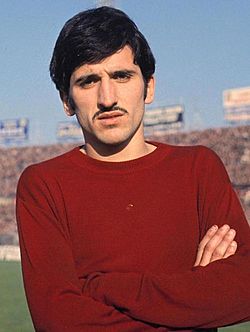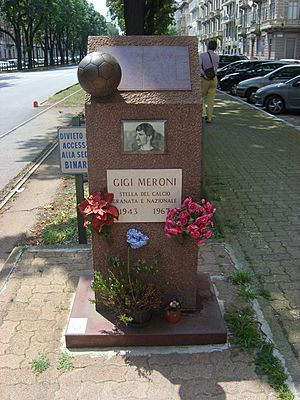Gigi Meroni facts for kids
 |
|||
| Personal information | |||
|---|---|---|---|
| Full name | Luigi Meroni | ||
| Date of birth | 24 February 1943 | ||
| Place of birth | Como, Italy | ||
| Date of death | 15 October 1967 (aged 24) | ||
| Place of death | Turin, Italy | ||
| Height | 1.70 m (5 ft 7 in) | ||
| Position(s) | Winger | ||
| Youth career | |||
| 19??–1960 | Libertas San Bartolomeo | ||
| 1960–1961 | Como | ||
| Senior career* | |||
| Years | Team | Apps | (Gls) |
| 1960–1962 | Como | 25 | (3) |
| 1962–1964 | Genoa | 42 | (7) |
| 1964–1967 | Torino | 103 | (22) |
| Total | 170 | (32) | |
| International career | |||
| 1964 | Italia B | 2 | (1) |
| 1966–1967 | Italy | 6 | (2) |
| *Club domestic league appearances and goals | |||
Luigi "Gigi" Meroni (born February 24, 1943 – died October 15, 1967) was a talented Italian football player. He was known for playing as a winger, which is a player who focuses on attacking from the sides of the field.
Gigi played 145 games in Italy's top league, Serie A, and scored 29 goals. He also played for the Italian national team six times between 1966 and 1967, scoring two goals. He even played in the 1966 FIFA World Cup.
Contents
Early Life and Football Start
Gigi Meroni came from a Romani background. He started playing football in a small courtyard. Later, he moved to a proper field in Como. Gigi lost his father when he was only two years old. His mother, Rosa, worked hard as a weaver to raise Gigi and his two siblings. Before becoming a professional footballer, Gigi worked as a designer for silk neckties. He also enjoyed painting.
Club Career Highlights
Meroni began his football journey in the youth teams of Como. He soon made his debut for their main team, even though they were in the second division. After playing for Como, he was transferred to Genoa.
Time at Genoa
At Genoa, Meroni became quite famous. However, he faced a challenge during his time there. In one match, he refused a doping control test. This led to him being suspended for the first five games of the 1963-64 Serie A season.
Moving to Torino
In 1964, Meroni moved to Torino, a team that was growing stronger. This transfer cost 300 million lira, which was a huge amount for a 21-year-old player back then. The fans of Genoa were not happy about him leaving.
Nickname and Lifestyle
Meroni earned the nickname la farfalla granata, meaning "the maroon butterfly." This name described his graceful playing style. It also referred to his unique and non-traditional outfits. He was also called the "beatnik del gol" because of his artistic interests and free-spirited lifestyle.
Partnership and Success
At Torino, Gigi Meroni formed a strong attacking team with striker Nestor Combin. Their partnership was very successful. Years later, Torino would have another famous attacking duo, Paolo Pulici and Francesco Graziani.
There were rumors that Torino's rivals, Juventus, wanted to buy Meroni for 750 million lire. However, Torino's president, Orfeo Pianelli, decided not to sell him. This was because the fans strongly wanted Meroni to stay.
In 1967, Meroni scored a famous goal at San Siro stadium. He dribbled past defenders and chipped the ball into the net. This goal helped Torino beat Grande Inter of Helenio Herrera, ending their three-year unbeaten home run.
International Career
Meroni played for the Italian national team six times between 1966 and 1967. He scored two goals for his country.
First Appearances
His first call-up for Italy was for a qualifying match against Poland in 1966. He made his debut on March 19, 1966, in a 0–0 draw against France.
He scored his first goal for Italy in Bologna on June 14, 1966. This was during a friendly match against Bulgaria, which Italy won 6–1. He scored another goal in a friendly match against Argentina eight days later.
1966 FIFA World Cup
Meroni was part of the Italian team that went to the 1966 FIFA World Cup in England. This tournament was not successful for Italy. They were surprisingly defeated 1–0 by North Korea and were eliminated early. Meroni had some disagreements with the coach, Edmondo Fabbri. Because of this, he only played in one game, against the USSR.
Playing Style
Gigi Meroni was known as La Farfalla Granata ("The Maroon Butterfly"). He was a fast, creative, and agile right winger. He wore the number 7 shirt. Meroni was a small, elegant, and very talented player. He was considered one of Italy's most promising wingers.
His greatest strength was his amazing dribbling ability. He could trick defenders with his clever moves. Meroni was very quick and mobile. He often made solo runs, dribbling past many defenders. He would then face the goalkeeper one-on-one before scoring.
Because of his unique style, which combined speed with grace and skill, Meroni was often compared to George Best. They also had similar appearances, including their Beatles–inspired hairstyles.
Tragic Death
On October 15, 1967, Gigi Meroni sadly died at the age of 24. This happened shortly after a 4–2 victory against Sampdoria. Meroni was hit by a car while crossing a street in Turin with his teammate Fabrizio Poletti.
Honours
Individual
- Torino F.C. Hall of Fame: 2015
See also
 In Spanish: Gigi Meroni para niños
In Spanish: Gigi Meroni para niños


